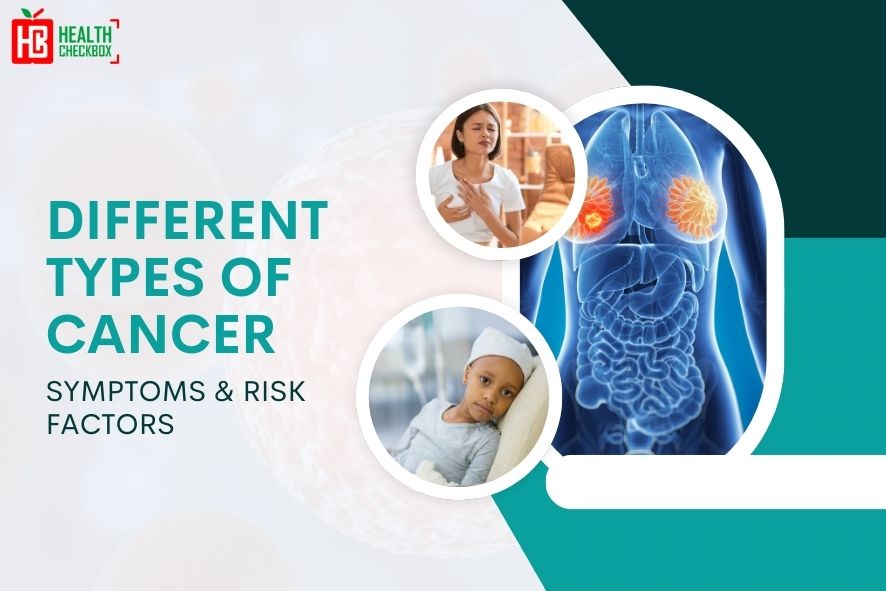When abnormal cells multiply and spread throughout the human body it leads to signs or growth of cancer. The skin, organs, bones, and blood are just a few places in the human body where it might begin. Cancer cells frequently differ in form from healthy cells and grow quickly in addition to invading and destroying close tissues. Lymphatic or circulatory systems move these cancer cells to other parts of the body. This condition is also known as metastasis. In this blog, we will explore the different types of cancer, their symptoms, and risk factors.
Different Types of Cancer
The organs or tissues in which cancers develop are the source of their names. There are many types of cancer, but we will list a few of these.
Carcinoma
This is the most common type of cancer disease found in both men and women. The epithelial cells that cover or line the outside and inside of the body.
Types of carcinoma
Following are the types of Carcinoma cancer:
- Melanoma
- Basal cell carcinoma
- Squamous cell skin cancer
- Merkel cell carcinoma
Sarcoma
A malignant tumor arises from connective tissues, such as fat, muscle, cartilage, bones, and tendons. Young people are the main victims of this kind of cancer. Another name for it is a bone tumor.
Types of sarcoma
Here are mentioned different kinds of Sarcoma cancer.
- Soft tissue sarcoma
- Osteosarcoma
- Chondrosarcoma
- Ewing’s sarcoma
Lymphoma
In this case, cancer begins in the brain, breast, or lymphoid system. They are responsible for producing white blood cells and purifying bodily fluids.
Types of Lymphoma
Following are the categories of Lymphoma cancer
- Hodgkin’s
- Lymphoblastic lymphoma
- Cutaneous
Leukemia
This is also known as blood cancer. It proceeds in the blood-forming tissue of the bone marrow. This keeps the marrow from producing normal red and white blood cells and platelets.
Different Forms of Leukemia Cancer
There are seven types of Blood cancer, which are as follows:
- Acute lymphocytic
- Acute nonlymphocytic
- Agnogenic myeloid
- Chronic lymphocytic leukemia
- Chronic myeloid
- Essential thrombocythemia
- Hairy cell leukemia
Brain and Spinal Cord Neoplasm
These tumors are masses of abnormal cells in the brain or medulla spinalis that have grown out of control. A lump of these cells can be malignant or non-cancerous. Both neoplasms can be life-threatening because they can press on and destroy healthy tissue. And they can cause serious damage to human health.
Common Brain and Spinal Cord Tumor Types
It is classified into three main types, which are mentioned below:
- Meningioma
- Glioma
- Astrocytoma
Explore the Risk Factors of Cancer
Some of the key elements that lead to the development of cancer are listed below.
Genetic Factor
- Genetic mutations that are inherited: A person’s chance of acquiring cancer may be raised by certain genetic mutations. These changes may arise spontaneously during DNA replication or be transmitted from parents.
- Somatic mutations: Unchecked cell growth and cancer can result from acquired genetic mutations that affect cells all over the body.
Environmental Factor
- Carcinogens: These are the popular matter known to increase the risk of cancer. These are listed below:
- Cigarette smoking (secondhand smoke)
- Radiation (like ionizing or non-ionizing)
- Chemicals (benzene, asbestos, arsenic)
- Infections (HPV, HBV, HCV)
- Viruses (Helicobacter pylori)
2. Lifestyle factors: These can increase the risk of cancer and they are mentioned below:
- Physical inactivity
- Poor diet
- Sun exposure
- Exposure to air pollution
- Intake of excessive alcohol
- UV radiation
Other Factors
- An endocrine disorder can contribute to the development of cancer.
- Impaired immune systems can increase the chances of cancer.
- HIV and certain types of bacteria and viruses can increase the danger of cancer.
Symptoms of Cancer
Below are some common symptoms of cancer that may need a healthcare expert attention:
General symptoms
- Weight loss or gain
- Bleeding
- Bruising
- Anemia
- Pain or discomfort
- Change in appetites
- Fatigue
Symptoms related to Organs
1. Breast Cancer
- Irritation and dimpling of breast skin.
- Flaky skin or redness in the nipple area.
- Pain in the nipple area.
- Changes in size or shape of the breast.
- Nipple discharge.
2. Lung Cancer
- Chest pain or discomfort
- Blood in cough
- Yellow or green mucus
- Continuous cough problem
3. Colorectal Cancer
- Constipation
- Blood in stool
- Pain in stomach
- Weight loss
- Cramps
4. Throat Cancer
- Difficulty in swallowing
- Hoarseness
- Tightness or pain in the throat
- Change in voice
5. Skin Cancer
- Redness
- Itching
- Burning sensation
- Sores
- Patches
- Lymph nodes
- Moles
- Ulcers
Diagnosis of Cancer
- Biopsy
- X-rays
- CT or CAT scans
- MRI scans
- Molecular Biology techniques
Treatment of Cancer
There are many methods to breakthrough cancer treatments. Which one is the best that works for you? This depends on some conditions, such as health, type, and stage of the health problem. The best cancer treatment can be determined with the help of your healthcare provider.
- Surgery
- Chemotherapy
- Radiation therapy
- Targeted therapy
- Immunotherapy
- Hormone therapy
- Transplant of Stem cell
Conclusion
Cancer is a complex disease that can affect anyone regardless of gender, age, or background. By being well-educated about the signs, causes, and types of cancer. We can take charge of our own and our loved ones’ safety if we have the appropriate knowledge and tools.
We should always remember that cancer does not kill. When it is detected and treated early. Most of the cancer types are treatable or curable.

